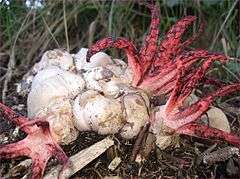Clathrus archeri
Clathrus archeri (synonyms Lysurus archeri, Anthurus archeri, Pseudocolus archeri), commonly known as octopus stinkhorn, or devil's fingers,[2] is a fungus which has a global distribution. The young fungus erupts from a suberumpent egg by forming into four to seven elongated slender arms initially erect and attached at the top. The arms then unfold to reveal a pinkish-red interior covered with a dark-olive spore-containing gleba. In maturity it smells like putrid flesh. Recently, C. archeri var. alba with white tentacles or arms has been reported from the Shola Forests in the Western Ghats, Kerala, India.[3]
| Clathrus archeri | |
|---|---|
 | |
| Octopus stinkhorn (Clathrus archeri) with sub-erumpent eggs | |
| Scientific classification | |
| Kingdom: | |
| Division: | |
| Class: | |
| Order: | |
| Family: | |
| Genus: | |
| Species: | C. archeri |
| Binomial name | |
| Clathrus archeri (Berk.) Dring 1980 | |
| Synonyms[1] | |
| Clathrus archeri | |
|---|---|
float | |
| glebal hymenium | |
| no distinct cap | |
| hymenium attachment is irregular or not applicable | |
| lacks a stipe | |
| spore print is olive-brown | |
| ecology is saprotrophic | |
| edibility: inedible | |
References
Notes
- "GSD Species Synonymy: Clathrus archeri (Berk.) Dring". Species Fungorum. CAB International. Retrieved 2015-12-08.
- Clathrus archeri (devil's fingers)
- Mohanan, C. (2011). Macrofungi of Kerala. Kerala, India.: Kerala Forest Research Institute. ISBN 978-81-85041-73-5.
Bibliography
- Arora, D; Burk, WR (1982). "Clathrus archeri, a stinkhorn new to North America". Mycologia. 74 (3): 501–504. doi:10.2307/3792972. JSTOR 3792972.
- Calonge, Francisco D. (1998) "Gasteromycetes, I. Lycoperdales, Nidulariales, Phallales, Sclerodermatales, Tulostomatale" in Flora Mycologica Iberica, Vol 3, J Cramer, Berlin, Germany. p. 271.
- Dring, DM (1980). "Contributions towards a rational arrangement of the Clathraceae". Kew Bulletin. 35 (1): 1–96. doi:10.2307/4117008. JSTOR 4117008.
- Pegler, DN et al. (1995) British Puffballs, Earthstars, and Stinkhorns, Royal Botanic Gardens, Kew, England. p. 255.
| Wikimedia Commons has media related to Clathrus archeri. |
This article is issued from Wikipedia. The text is licensed under Creative Commons - Attribution - Sharealike. Additional terms may apply for the media files.